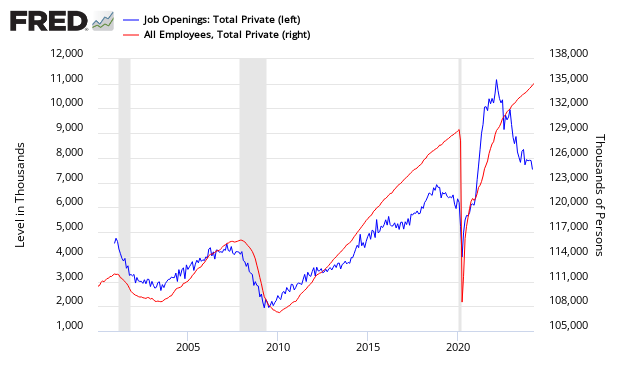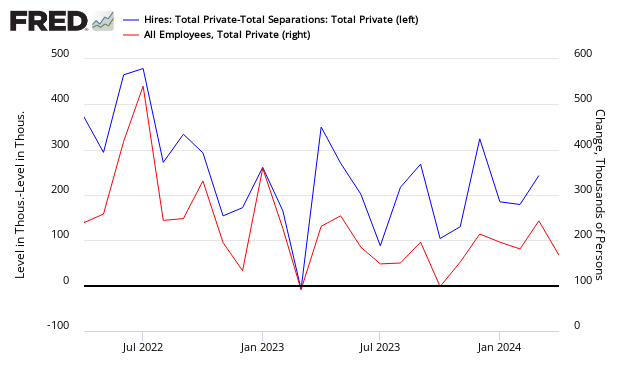December 2013 JOLTS Again Predicts Little Change In The Jobs Situation
The BLS Job Openings and Labor Turnover Survey (JOLTS) can be used as a predictor of future jobs growth, and the predictive elements show that the jobs situation growth rate likely will not change either for the good or the bad.
- the number of seasonally adjusted PRIVATE jobs openings – which is the most predictive of the JOLTS elements – growth accelerated 5.9% from last month, and up 12.6% (versus 6.8% from last month) from one year ago. However, the seasonally adjusted jobs opening rate (percent of job openings compared to size of workforce) was unchanged again. This indicates that future jobs growth rate likely will not accelerate.
- Unadjusted PRIVATE hires year-over-year growth was declined 1.5% month-over-month and PRIVATE separations grew 2.6% month-over-month – in theory meaning the employment situation is very marginally worse. However, this portion of the JOLTS report has shown little predictive ability.
The relevance of JOLTS to future employment is obvious from the graphic below which shows JOLTS Job Openings leading or coincident to private non-farm employment. JOLTS job openings are a good predictor of jobs growth turning points.
Adjusted Private Jobs Openings from JOLTS (blue line, left axis) compared to BLS Non-farm Private (red line, right axis)

The graph below uses year-over year growth comparisons of non-seasonally adjusted non-farm private BLS data versus JOLTS Job Openings – and then compare trend lines. JOLTS is suggesting that the rate of improvement the jobs situation will not change (either for the worse or for the better).
Year-over-Year Change – Seasonally Jobs Openings from JOLTS (blue line, left axis) compared to Unadjusted BLS Non-farm Private (red line, right axis)

The JOLTS Unadjusted Private hires rate (percent of separations compared to size of workforce) went from 3.7 last month to 3.6 - and the separations rate (percent of separations compared to size of workforce) was grew from 3.5 to 3.6. Separations are the workforce which quit or was laid off. Likewise, hires are the workforce hired.
Hires (blue line) and Separation Rates (red line) – Non-Farm Private

However, please note that Econintersect has not been able use the hire rate or the separation rate (or a combination thereof) to help in understanding future jobs growth. A Philly Fed study agrees with Econintersect’s assessment. JOLTS is issued a month later than the jobs data – and correlates against one month old data. The data in the below chart shows that the JOLTS data is turning at the same points – but the JOLTS data is released one month later making this a lagging indicator.
Hires less Separation Rate (blue line, left axis) compared to Non-Farm Private BLS Non-farm Private (red line, right axis)

Caveats on the Use of JOLTS
This data series historically is very noisy which likely is a result of data gathering issues and/or seasonal adjustments. Therefore this series must be trended to provide any understanding of the dynamics. One of two months of good or bad data are not predictive
None.




